-
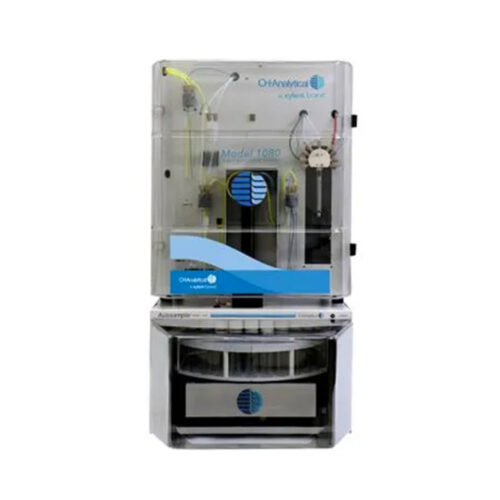 Total organic carbon (TOC) measurement is a well-established technique that provides valuable information about water quality for process control and regulatory compliance. Though high-temperature combustion TOC has been shown to be very effective for the analysis of samples that are of high molecular weight or contain substantial amounts of salt or difficult-to oxidize organics (e.g, humic acid), these types of samples are problematic for combustion TOC analyzers.
Total organic carbon (TOC) measurement is a well-established technique that provides valuable information about water quality for process control and regulatory compliance. Though high-temperature combustion TOC has been shown to be very effective for the analysis of samples that are of high molecular weight or contain substantial amounts of salt or difficult-to oxidize organics (e.g, humic acid), these types of samples are problematic for combustion TOC analyzers. -
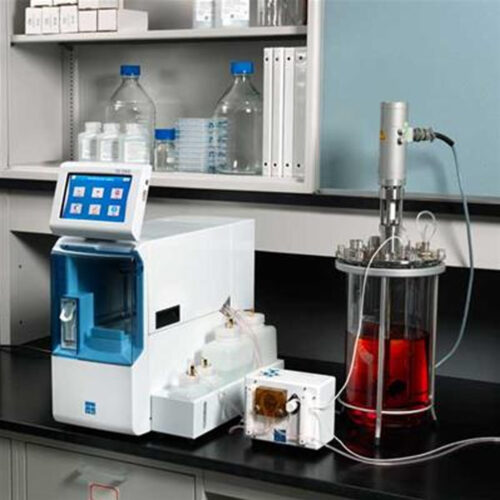
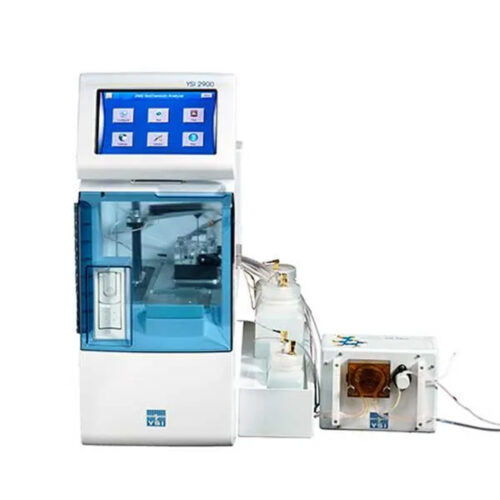 The YSI 2900M Online Monitoring & Control System featuring the YSI 2960 Online Sampler is a key and reliable partner for the monitoring and optimization of your bioprocess. The YSI 2960 Online Sampler automatically draws fluids from your bioreactor and delivers samples directly to the YSI 2900 Biochemistry Analyzer for testing. Sampling is done aseptically as lines are flushed and antiseptic is kept in them after each draw. The system supports connection with RS232, Ethernet, and OPC. The YSI 2900M Online Monitoring & Control System provides a simple and reliable solution for running your bioprocess automatically with little risk of contamination.
The YSI 2900M Online Monitoring & Control System featuring the YSI 2960 Online Sampler is a key and reliable partner for the monitoring and optimization of your bioprocess. The YSI 2960 Online Sampler automatically draws fluids from your bioreactor and delivers samples directly to the YSI 2900 Biochemistry Analyzer for testing. Sampling is done aseptically as lines are flushed and antiseptic is kept in them after each draw. The system supports connection with RS232, Ethernet, and OPC. The YSI 2900M Online Monitoring & Control System provides a simple and reliable solution for running your bioprocess automatically with little risk of contamination. -
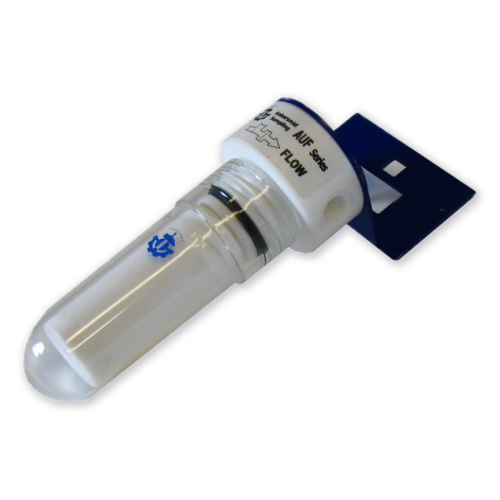
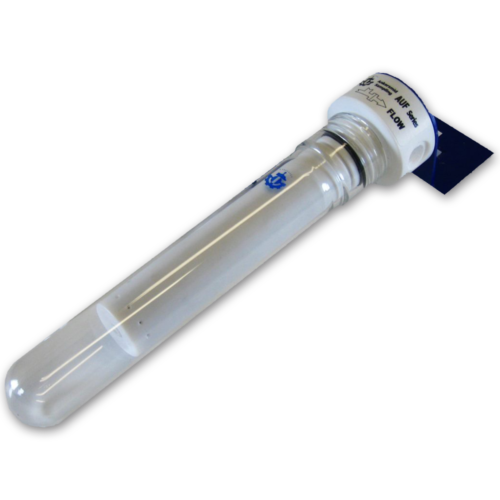
Ankersmid Universal Filters are known as a reliable technique for the adsorption of components in a gas stream that cause interferences in the gas measurement.
The design of the filter and filter housing ensures that any liquids present in the gas will be separated and collected in the bottom of the filter-housing.
The AAM series are based on the elements of the AUF universal filter series.
Due to its universal standard design, the filters can be used with various adsorption cartridges and, if needed, also be fitted with a liquid sensor.
-
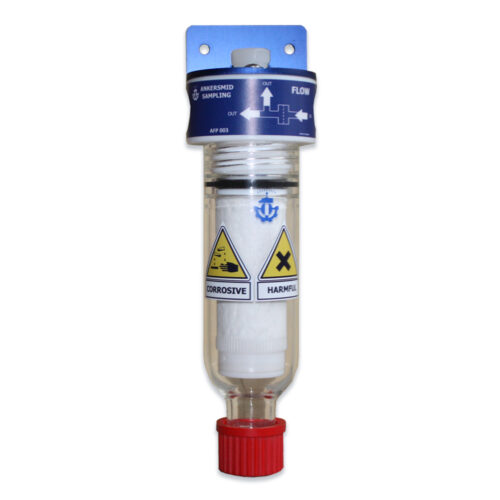
The Ankersmid fluid particle filter or coalescence filter is suitable for filtration of fluid particles of all types and is recommended for sample gases with an acid dew point above 100 °C. Application examples are measurements in flue gas of heavy oil and black coal combustions.
The filter separates the aerosols (very fine fluid particles) which still pass the gas cooler. The most effective position of the filter is downstream the sample conditioning close to the flow meter of the analyser. For additional system protection we provide the version with integrated hydrophobic diaphragm, working as a liquid stop.
-
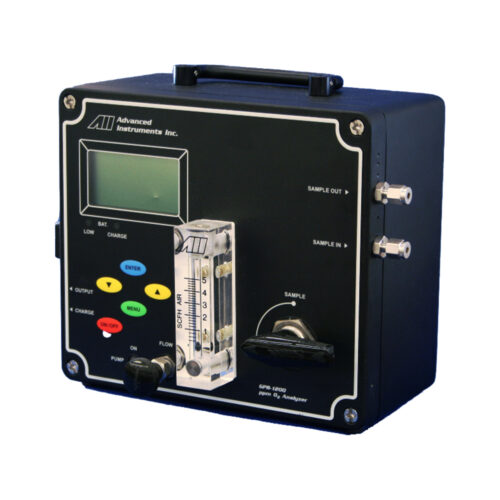 De zeer nauwkeurige draagbare zuurstofanalysatoren van Analytical Industries zijn bedoeld voor toepassingen die op verschillende gedefinieerde meetpunten moeten worden gecontroleerd. Het GPR-3500-model heeft een compacte, robuuste behuizing en bevat roestvrijstalen onderdelen die in contact komen met de vloeistof, geïntegreerde debietmeters en naaldventielen. Het meet de zuiverheid voor inerte gassen, kooldioxide en zuurstof. De GPR-1200 compacte draagbare zuurstofanalyser voor sporen heeft een 4-wegklep die een gasmonster in de sensor opvangt. Dit maakt snellere zuurstofmeettijden mogelijk bij het verplaatsen van punt naar punt in een proces en beschermt ook sporenzuurstofsensoren tegen voortijdige uitputting als gevolg van blootstelling aan omgevingszuurstofniveaus om hun levensduur te verlengen. Dit alles zorgt voor een zuinige werking en lage eigendomskosten voor deze toonaangevende reeks draagbare zuurstofanalysers.
De zeer nauwkeurige draagbare zuurstofanalysatoren van Analytical Industries zijn bedoeld voor toepassingen die op verschillende gedefinieerde meetpunten moeten worden gecontroleerd. Het GPR-3500-model heeft een compacte, robuuste behuizing en bevat roestvrijstalen onderdelen die in contact komen met de vloeistof, geïntegreerde debietmeters en naaldventielen. Het meet de zuiverheid voor inerte gassen, kooldioxide en zuurstof. De GPR-1200 compacte draagbare zuurstofanalyser voor sporen heeft een 4-wegklep die een gasmonster in de sensor opvangt. Dit maakt snellere zuurstofmeettijden mogelijk bij het verplaatsen van punt naar punt in een proces en beschermt ook sporenzuurstofsensoren tegen voortijdige uitputting als gevolg van blootstelling aan omgevingszuurstofniveaus om hun levensduur te verlengen. Dit alles zorgt voor een zuinige werking en lage eigendomskosten voor deze toonaangevende reeks draagbare zuurstofanalysers. -
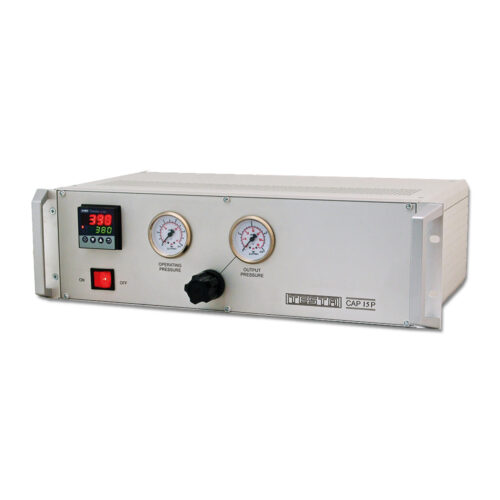 The air purifier CAP 15 and CAP 30 produces clean and hydrocarbon-free air out of normal compressed air. The Pt/Pd-catalyst convert by catalytical total-oxidation at 370°C all hydrocarbons inclusive methane (CH4) into carbondioxyde (CO2) and water (H2O). Hydrogen (H2) and carbonmonoxyde (CO) will be removed quantitatively.The produced air quality ist constantly free of hydrocarbons and better than sythetic air from gas bottles of class 5.0 (refering to organic components).On account of the high gas purity, the air purifier CAP 15/30 are used for FID-measuring systems as combustion air and as zero gas.
The air purifier CAP 15 and CAP 30 produces clean and hydrocarbon-free air out of normal compressed air. The Pt/Pd-catalyst convert by catalytical total-oxidation at 370°C all hydrocarbons inclusive methane (CH4) into carbondioxyde (CO2) and water (H2O). Hydrogen (H2) and carbonmonoxyde (CO) will be removed quantitatively.The produced air quality ist constantly free of hydrocarbons and better than sythetic air from gas bottles of class 5.0 (refering to organic components).On account of the high gas purity, the air purifier CAP 15/30 are used for FID-measuring systems as combustion air and as zero gas. -
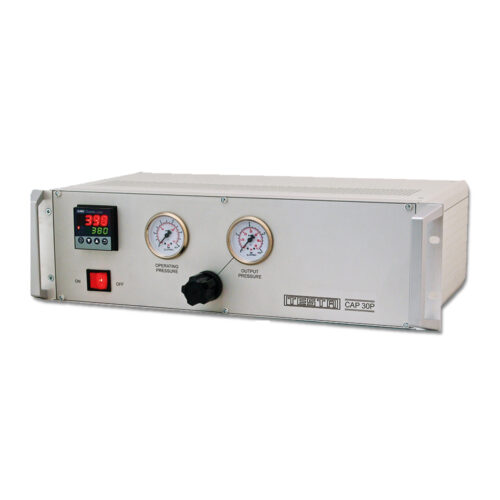 The air purifier CAP 15 and air purifier CAP 30 produces clean and hydrocarbon-free air out of normal compressed air. The Pt/Pd-catalyst convert by catalytical total-oxidation at 370°C all hydrocarbons inclusive methane (CH4) into carbondioxyde (CO2) and water (H2O). Hydrogen (H2) and carbonmonoxyde (CO) will be removed quantitatively.The produced air quality ist constantly free of hydrocarbons and better than sythetic air from gas bottles of class 5.0 (refering to organic components).On account of the high gas purity, the air purifier CAP 15/30 are used for FID-measuring systems as combustion air and as zero gas
The air purifier CAP 15 and air purifier CAP 30 produces clean and hydrocarbon-free air out of normal compressed air. The Pt/Pd-catalyst convert by catalytical total-oxidation at 370°C all hydrocarbons inclusive methane (CH4) into carbondioxyde (CO2) and water (H2O). Hydrogen (H2) and carbonmonoxyde (CO) will be removed quantitatively.The produced air quality ist constantly free of hydrocarbons and better than sythetic air from gas bottles of class 5.0 (refering to organic components).On account of the high gas purity, the air purifier CAP 15/30 are used for FID-measuring systems as combustion air and as zero gas -
 Equip your lab with the accurate, easy to use Thermo Scientific™ Orion™ AquaMate 8000 UV-Vis Spectrophotometer to ensure you have the ideal instrument for water analysis and beyond. This spectrophotometer offers 260 preprogrammed methods for ion concentration from absorbance plus wavelength scanning function and standard curve function for creating custom method using so virtually any brand of colorimetric reagent can be used. Utilize 190-1100 nm selectable wavelengths, 1.8 nm spectral bandwidth and vial flexibility with the included 3-position carousel for holding round and rectangular vials. Other more simple models available!
Equip your lab with the accurate, easy to use Thermo Scientific™ Orion™ AquaMate 8000 UV-Vis Spectrophotometer to ensure you have the ideal instrument for water analysis and beyond. This spectrophotometer offers 260 preprogrammed methods for ion concentration from absorbance plus wavelength scanning function and standard curve function for creating custom method using so virtually any brand of colorimetric reagent can be used. Utilize 190-1100 nm selectable wavelengths, 1.8 nm spectral bandwidth and vial flexibility with the included 3-position carousel for holding round and rectangular vials. Other more simple models available! -
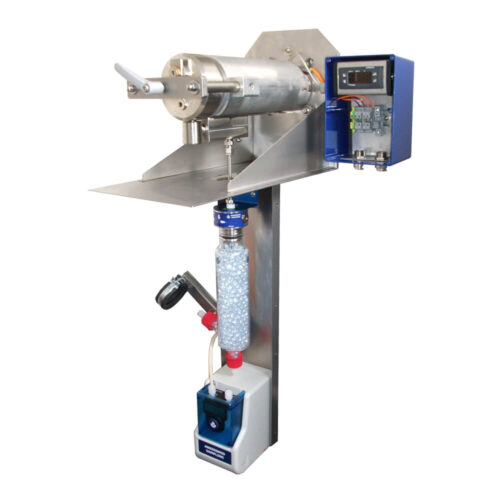 The probe type ASP 320 is based on the standard Ankersmid sample probe. Due to its modular and innovative design the Ankersmid heated sample probe cover also meet the special requirements of above mentioned application. With the heated filter body a filter element of 150mm length, suitable for most applications up to 1g dust/m3, is integrated. When the integrated port is used for back-flush higher dust loads can be handled. Additional a pre-filter can be mounted on top of the sample probe. The filter element can be replaced without any tools and in the shortest possible time. At the sample gas outlet of the probe a special non-heated condensate vessel of glass is mounted. It is filled with glass balls to extend the surface for the salification. The salt deposits and will be washed out with the condensate. A peristaltic pump type ASR25 continuously removes the condensate with the solved ammonium salts. The temperature of the vessel is higher than the ambient temperature because of the hot gas stream. Therefore a loss of measured components is negligible because of warm condensate. In case of a DeNOx application with a small content of NH3 (normally only a few ppm) it is possible to analyse SO2 and NOX without great losses (only some ppm which normally can be neglected). To determine the loss, it is possible to give test gas via the probe to the analyser(s). A measuring fault can be found and calibrated. As an option the vessel can be heated as well to suppress chemical reactions of the measured component below a defined temperature. At the sample outlet of the vessel a heated gas sample line series AHL can be connected.
The probe type ASP 320 is based on the standard Ankersmid sample probe. Due to its modular and innovative design the Ankersmid heated sample probe cover also meet the special requirements of above mentioned application. With the heated filter body a filter element of 150mm length, suitable for most applications up to 1g dust/m3, is integrated. When the integrated port is used for back-flush higher dust loads can be handled. Additional a pre-filter can be mounted on top of the sample probe. The filter element can be replaced without any tools and in the shortest possible time. At the sample gas outlet of the probe a special non-heated condensate vessel of glass is mounted. It is filled with glass balls to extend the surface for the salification. The salt deposits and will be washed out with the condensate. A peristaltic pump type ASR25 continuously removes the condensate with the solved ammonium salts. The temperature of the vessel is higher than the ambient temperature because of the hot gas stream. Therefore a loss of measured components is negligible because of warm condensate. In case of a DeNOx application with a small content of NH3 (normally only a few ppm) it is possible to analyse SO2 and NOX without great losses (only some ppm which normally can be neglected). To determine the loss, it is possible to give test gas via the probe to the analyser(s). A measuring fault can be found and calibrated. As an option the vessel can be heated as well to suppress chemical reactions of the measured component below a defined temperature. At the sample outlet of the vessel a heated gas sample line series AHL can be connected. -
 ASP-CON can be installed permanently into several different areas in the Secondary Wastewater Treatment Plant to provide feed-forward or feed-back control for plant operation and optimisation. The ASP-Con carries out several continuous measurements, and also analyses discrete batch samples of the product to give the following parameters on a frequency which the plant operator can set:
ASP-CON can be installed permanently into several different areas in the Secondary Wastewater Treatment Plant to provide feed-forward or feed-back control for plant operation and optimisation. The ASP-Con carries out several continuous measurements, and also analyses discrete batch samples of the product to give the following parameters on a frequency which the plant operator can set:- DO
- Temperature
- Ammonium
- Potassium*
- pH*
- ORP*
- MLSS
- SVI/SSVI
- TSS (predicted)
- RAS Concentration
- Nitrification Levels*
- Oxygen Uptake Rate
- Specific Oxygen Uptake Rate
- Critical Oxygen Concentration Points
- Toxicity Management
-
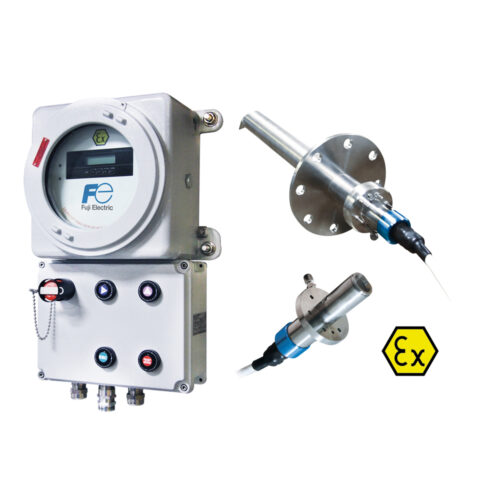 Ex-proof in situ zirconia oxygen analyzer for combustion controlThe oxygen measurement enables the control of burner fuel/air ratios to ensure combustion efficiency and process safety. Fuji Electric O2 Analyser is adapted to be installed in hazardous areas and to withstand critical environments as:
Ex-proof in situ zirconia oxygen analyzer for combustion controlThe oxygen measurement enables the control of burner fuel/air ratios to ensure combustion efficiency and process safety. Fuji Electric O2 Analyser is adapted to be installed in hazardous areas and to withstand critical environments as:- Refinery process heaters
- Petrochemical reactor furnaces
- Industrial large scale boilers
-
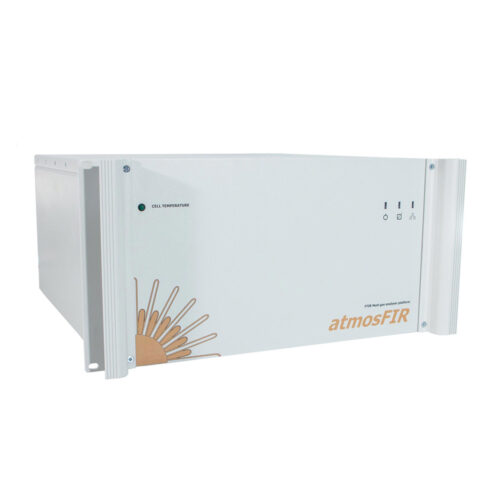 atmosFIR is the successor to Protea's previous emissions monitoring FTIR systems, keeping all the features that users found valuable in achieving their measurement results, but offering the benefits of the new atmosFIR platform with increased portability, lower ownership costs and increased measurement performance. atmosFIR can be considered a simple multi-gas analyser for combustion gas measurements; indeed for some users that is all it will be and as such it provides a cost-effective and complete measurement system. However, for the expert user atmosFIR will offer all the benefits of FTIR, with hundreds of gas measurements, multiple analytical ranges, in-depth chemometric result diagnoses and dedicated on-board sampling system. With Protea's in-house chemometrics application support and 15+ year history of emission monitoring projects, atmosFIR offers the user the complete package for their monitoring needs. With long-lifetime VCSEL reference laser diode, unique cell design, and air cooled DTGS detector with 24-bit ADC, atmosFIR is a step-change in value and service lifetime for FTIR emission gas analysis.
atmosFIR is the successor to Protea's previous emissions monitoring FTIR systems, keeping all the features that users found valuable in achieving their measurement results, but offering the benefits of the new atmosFIR platform with increased portability, lower ownership costs and increased measurement performance. atmosFIR can be considered a simple multi-gas analyser for combustion gas measurements; indeed for some users that is all it will be and as such it provides a cost-effective and complete measurement system. However, for the expert user atmosFIR will offer all the benefits of FTIR, with hundreds of gas measurements, multiple analytical ranges, in-depth chemometric result diagnoses and dedicated on-board sampling system. With Protea's in-house chemometrics application support and 15+ year history of emission monitoring projects, atmosFIR offers the user the complete package for their monitoring needs. With long-lifetime VCSEL reference laser diode, unique cell design, and air cooled DTGS detector with 24-bit ADC, atmosFIR is a step-change in value and service lifetime for FTIR emission gas analysis. -
 atmosFIR CEM is a complete emissions monitoring system incorporating the atmosFIR 19” FTIR analyser. As completely hot and wet emissions measurement, atmosFIR CEM is ideal for complete measurement of multiple gases from applications such as incineration and power. A standard gas suite of NO, NO2, N2O, SO2, NH3, HCl, CH4, O2, CO2 and H2O is provided, but with the powerful FTIR analyser, further gases can be added easily in software. At the heart of system is the high-resolution, robust and proven FTIR spectrometer offering high signal throughput, low-noise and long lifetime of components. atmosFIR has been developed to incorporate the latest improvements and advantages in technology, The atmosFIR FTIR analyser contains an in-built sampling system and is designed for ppm-level emissions monitoring. The analyser can be used as a portable or bench-top unit as well as part of the installed CEM system.
atmosFIR CEM is a complete emissions monitoring system incorporating the atmosFIR 19” FTIR analyser. As completely hot and wet emissions measurement, atmosFIR CEM is ideal for complete measurement of multiple gases from applications such as incineration and power. A standard gas suite of NO, NO2, N2O, SO2, NH3, HCl, CH4, O2, CO2 and H2O is provided, but with the powerful FTIR analyser, further gases can be added easily in software. At the heart of system is the high-resolution, robust and proven FTIR spectrometer offering high signal throughput, low-noise and long lifetime of components. atmosFIR has been developed to incorporate the latest improvements and advantages in technology, The atmosFIR FTIR analyser contains an in-built sampling system and is designed for ppm-level emissions monitoring. The analyser can be used as a portable or bench-top unit as well as part of the installed CEM system. -
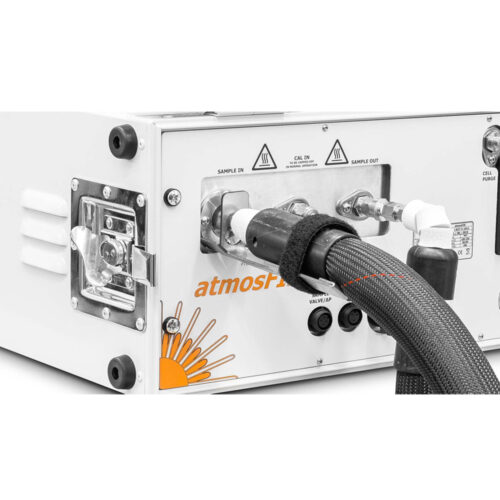
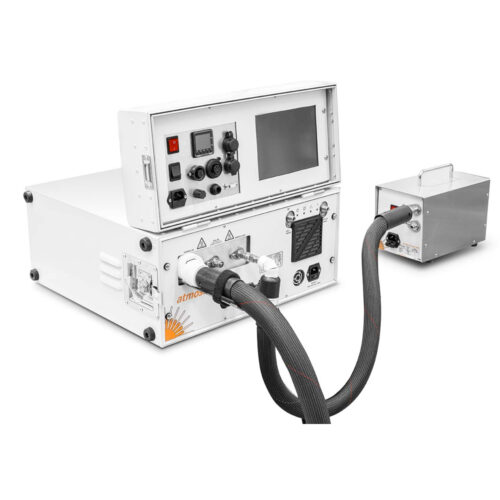 atmosFIRt is the latest generation of FTIR gas analyser technology from Protea in a portable or mobile form. The atmosFIR system improves upon previous FTIR technology and represents one of the most cost-effective and flexible analytical products on the market today. At the heart of atmosFIR is a high-resolution, robust and proven FTIR spectrometer offering high signal throughput, low-noise and long lifetime of components. atmosFIR has been developed to incorporate the latest improvements and advantages in technology.
atmosFIRt is the latest generation of FTIR gas analyser technology from Protea in a portable or mobile form. The atmosFIR system improves upon previous FTIR technology and represents one of the most cost-effective and flexible analytical products on the market today. At the heart of atmosFIR is a high-resolution, robust and proven FTIR spectrometer offering high signal throughput, low-noise and long lifetime of components. atmosFIR has been developed to incorporate the latest improvements and advantages in technology. -
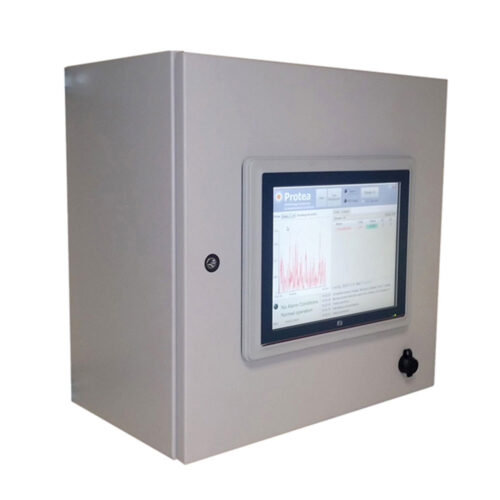 atmosFIR is the latest generation of gas analyser technology from Protea. The atmosFIR system improves upon previous FTIR technology and represents one of the most cost-effective and flexible analytical products on the market today. atmosFIRw has been designed to give a complete measurement system with embedded touchscreen controller. At the heart of atmosFIRw is a high-resolution, robust and proven FTIR spectrometer offering high signal throughput, low-noise and long lifetime of components. atmosFIRw has been developed to incorporate the latest improvements and advantages in technology, including:
atmosFIR is the latest generation of gas analyser technology from Protea. The atmosFIR system improves upon previous FTIR technology and represents one of the most cost-effective and flexible analytical products on the market today. atmosFIRw has been designed to give a complete measurement system with embedded touchscreen controller. At the heart of atmosFIRw is a high-resolution, robust and proven FTIR spectrometer offering high signal throughput, low-noise and long lifetime of components. atmosFIRw has been developed to incorporate the latest improvements and advantages in technology, including:- Low cost of ownership and maintenance
- Robust and light, including the latest in fabrication materials
- atmosFIR combines an FTIR analyser with an in-built sampling system and embedded PC controller for a complete system
-
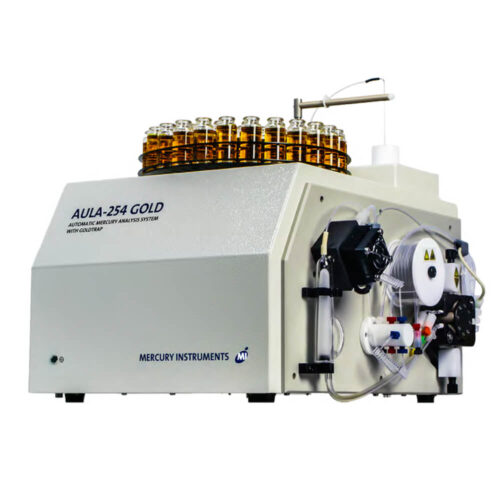 The AULA 254 is used for fully automatic determination of mercury traces in liquid samples and sample digests. The instrument carries out routine analysis: sample after sample following exactly the preselected procedure thus increasing efficiency and productivity of your lab. The working principle of the system is based on the continuous flow method. First the mercury contained in the sample is transformed into the elemental state by addition of a reducing agent to the sample flow. In a cross-flow reactor the mercury is stripped with a gas stream and carried into the optical cell which is made entirely of fused silica. There the quantitative determination of mercury is obtained by measuring UV absorption at a wavelength of 253,7 nm at room temperature. This analytical technique is commonly known as cold vapor atomic absorption spectrometry (CVAAS), a method that has proved itself as extremely sensitive and selective over many years. No long purging or rinsing procedures even when samples with high concentrations are analyzed. The typical duration of a full measurement cycle is 80 … 280 seconds. The quick screening mode allows performing analyses in even a shorter time.
The AULA 254 is used for fully automatic determination of mercury traces in liquid samples and sample digests. The instrument carries out routine analysis: sample after sample following exactly the preselected procedure thus increasing efficiency and productivity of your lab. The working principle of the system is based on the continuous flow method. First the mercury contained in the sample is transformed into the elemental state by addition of a reducing agent to the sample flow. In a cross-flow reactor the mercury is stripped with a gas stream and carried into the optical cell which is made entirely of fused silica. There the quantitative determination of mercury is obtained by measuring UV absorption at a wavelength of 253,7 nm at room temperature. This analytical technique is commonly known as cold vapor atomic absorption spectrometry (CVAAS), a method that has proved itself as extremely sensitive and selective over many years. No long purging or rinsing procedures even when samples with high concentrations are analyzed. The typical duration of a full measurement cycle is 80 … 280 seconds. The quick screening mode allows performing analyses in even a shorter time. -

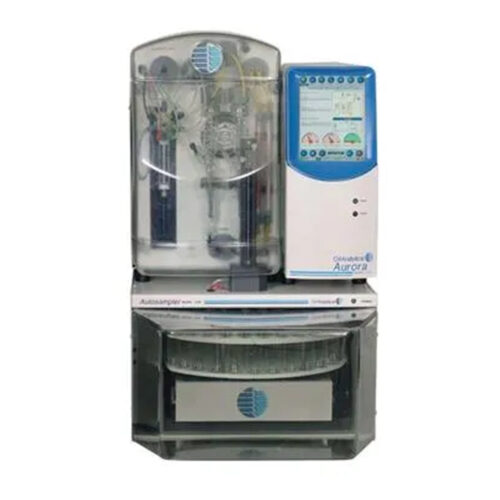 The Aurora 1030 line of TOC analyzers from OI Analytical includes instrument configurations for laboratory and process monitoring, employing 100 °C persulfate wet oxidation or thermal combustion techniques. The Aurora 1030 line incorporates several noteworthy innovations and can be equipped with parallel reactors allowing concurrent sample processing for increased analytical throughput. The unique 1030D Dual Mode TOC analyzer allows sample processing by wet oxidation or thermal combustion using the same instrument.
The Aurora 1030 line of TOC analyzers from OI Analytical includes instrument configurations for laboratory and process monitoring, employing 100 °C persulfate wet oxidation or thermal combustion techniques. The Aurora 1030 line incorporates several noteworthy innovations and can be equipped with parallel reactors allowing concurrent sample processing for increased analytical throughput. The unique 1030D Dual Mode TOC analyzer allows sample processing by wet oxidation or thermal combustion using the same instrument. -

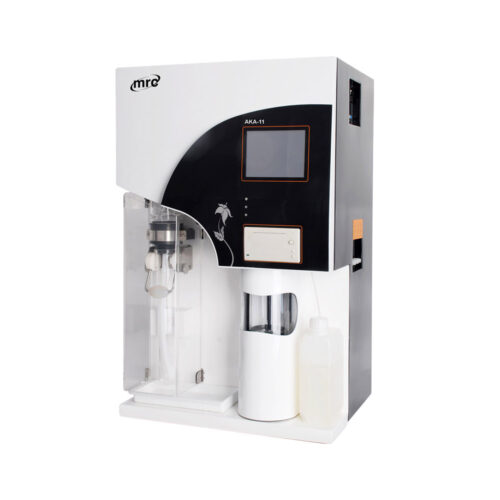
De Kjeldahl-methode is een methode geschikt om de fractie organische stikstof in samples te bepalen. De methode zal de hoeveelheid stikstof en ammoniak die in organische verbindingen vervat zit analyseren, enkel stikstof in de vorm van nitraten en nitrieten verbindingen worden genegeerd.
Deze erg oude methode is nog steeds de meest “populaire” (lees erkende) methode voor het bepalen van Stikstof in waters en voedsel samples.
Omwille van de chemicaliën en de hogere temperaturen die zich in het Kjeldahl proces voordoen is Kjeldahl lang een ongewenste gast op het labo geweest daar de nodige voorzichtigheid aangewezen is.
Vandaag zijn deze analyses bijna volledig geautomatiseerd, beveiligd en gecontroleerd zodat het gebruik van deze analyzers haast kinderspel geworden is.
-
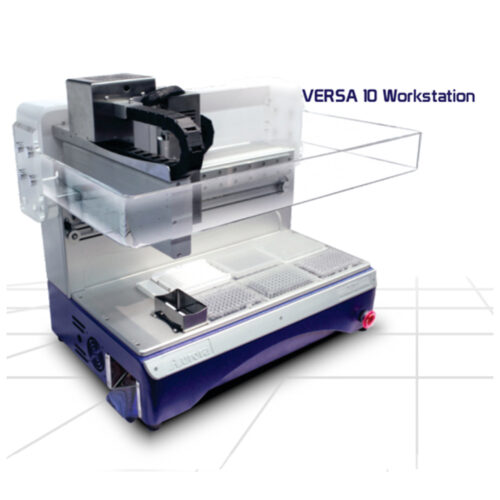
Het VERSA 10 werkstation is een compacte, kost effectieve, high throughput, automatische air-displacement vloeistof sampler.
Het systeem bied een oplossing voor de nood aan hoge doorvoer vloeistof behandelings mogelijkheden van een klein benchtop model tot een uitgebreid vloer model. Door het combineren van een 4 of 8 kanaals kop maar wel met single kanaals functionaliteit kan dit workstation de routine protocollen automatiseren met een variabele hoeveelheid aan samples. Het compacte 6positie werkplatform zorgt ervoor dat u de pipetteer protocollen kunt uitvoeren in een bio-afzuigkap of plekken met beperkte ruimte.
Dit systeem ondersteund verschillende eigen reagentia en labware door zijn open systeem en dit aan een zeer aantrekkelijke prijs.
-
 The heated sampling system is a combination of a heated sample line and a heated sample filter. The sample line is 500mm long; the filter element can be replaced very quick with the bayonet lock. Beside the very precisious and constant regulation of the line and filter temperature, there is a separate controll point fort he temperature at the filterinlet, where you have an information of the exhaust gas temperature. Also the calibration gas (prewarmed) can directly connected with the unit. The thermocouple is available as PT 100 or NiCrNi.
The heated sampling system is a combination of a heated sample line and a heated sample filter. The sample line is 500mm long; the filter element can be replaced very quick with the bayonet lock. Beside the very precisious and constant regulation of the line and filter temperature, there is a separate controll point fort he temperature at the filterinlet, where you have an information of the exhaust gas temperature. Also the calibration gas (prewarmed) can directly connected with the unit. The thermocouple is available as PT 100 or NiCrNi. -
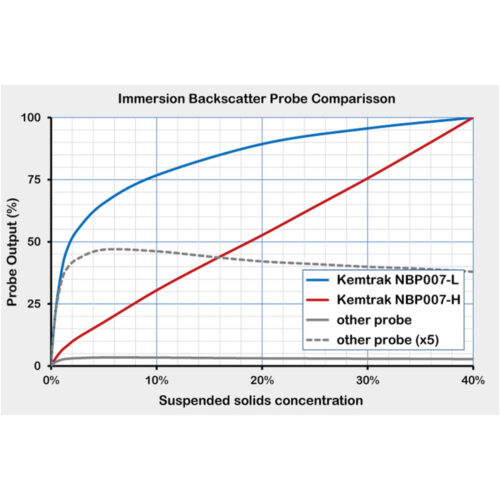
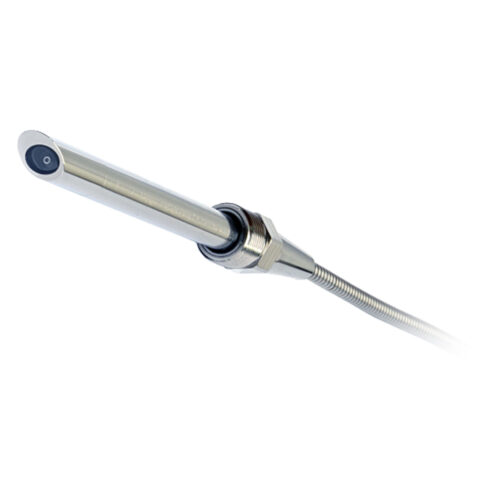 Kemtrak backscatter probes are designed to accurately measure low to extremely high turbidity directly in tanks and pipelines. The dual fiber optic design of the Kemtrak probe provides high resolution at low turbidity ranges with excellent linearity all the way up to extremely high turbidities when used with a Kemtrak NBP007 backscatter photometer. A unique benefit of the Kemtrak backscatter immersion probe is that it does not go blind at high sample turbidities. Other probes stop working at 4 000 NTU/FNU (< 1 wt% solids) after which the signal will decrease resulting in an erroneous and misleading output. The output of the Kemtrak probe will continue to increase with sample concentration ensuring a reliable measurement.
Kemtrak backscatter probes are designed to accurately measure low to extremely high turbidity directly in tanks and pipelines. The dual fiber optic design of the Kemtrak probe provides high resolution at low turbidity ranges with excellent linearity all the way up to extremely high turbidities when used with a Kemtrak NBP007 backscatter photometer. A unique benefit of the Kemtrak backscatter immersion probe is that it does not go blind at high sample turbidities. Other probes stop working at 4 000 NTU/FNU (< 1 wt% solids) after which the signal will decrease resulting in an erroneous and misleading output. The output of the Kemtrak probe will continue to increase with sample concentration ensuring a reliable measurement. -
 The heated prefilter model iFiD Filter Backwash M1is a samplegasfilter which can flushbacked with an electronic solenoid valve. This valve can controll the pressure air (flushbackair) and the sample gas. The filter is very stable with the temperature level you preselect, and also in permanent use. In permanent use the maximum temperature is 200°C. The temperature is regulated in a range of +-1%.
The heated prefilter model iFiD Filter Backwash M1is a samplegasfilter which can flushbacked with an electronic solenoid valve. This valve can controll the pressure air (flushbackair) and the sample gas. The filter is very stable with the temperature level you preselect, and also in permanent use. In permanent use the maximum temperature is 200°C. The temperature is regulated in a range of +-1%. -
 The MC-3000 is used for generating a continuous stream of a mercury vapor loaded gas stream in order to check or calibrate mercury analyzers. It is also suitable for all those applications where a gas stream with a preset and constant mercury concentration is needed.
The MC-3000 is used for generating a continuous stream of a mercury vapor loaded gas stream in order to check or calibrate mercury analyzers. It is also suitable for all those applications where a gas stream with a preset and constant mercury concentration is needed.- Generates elemental mercury vapor
- continuous operation
- approx. 10 ... 500 µg/m³ Hg°
- Compact and portable size
- No permeation principle - no need to calibrate the calibrator
- Microprocessor controlled
-
 The all new Chip-DSC 1 integrates all essential parts of DSC: furnace, sensor and electronics in a miniaturized housing. The chip-arrangement comprises the heater and temperature sensor in a chemically inert ceramic arrangement with metallic heater and temperature sensor. This arrangement allows superior reproducibility and due to the low mass outstanding temperature control and heating rates of up to 100 K/min. The integrated sensor is easily user exchangeable and available for a low cost. The integrated design of the chip-sensor delivers superior raw data, which enables a direct analysis without pre- or post-processing of heat flow data. The compact construction, leads to a significant reduction in production cost which can be passed on to our customers. The low energy consumption and unrivaled dynamic response result in unsurpassed performance of this revolutionary DSC-concept.
The all new Chip-DSC 1 integrates all essential parts of DSC: furnace, sensor and electronics in a miniaturized housing. The chip-arrangement comprises the heater and temperature sensor in a chemically inert ceramic arrangement with metallic heater and temperature sensor. This arrangement allows superior reproducibility and due to the low mass outstanding temperature control and heating rates of up to 100 K/min. The integrated sensor is easily user exchangeable and available for a low cost. The integrated design of the chip-sensor delivers superior raw data, which enables a direct analysis without pre- or post-processing of heat flow data. The compact construction, leads to a significant reduction in production cost which can be passed on to our customers. The low energy consumption and unrivaled dynamic response result in unsurpassed performance of this revolutionary DSC-concept. -
 The all new Chip-DSC 10 integrates all essential parts of DSC: furnace, sensor and electronics in a miniaturized housing. The chip-arrangement comprises the heater and temperature sensor in a chemically inert ceramic arrangement with metallic heater and temperature sensor. This arrangement allows superior reproducibility and due to the low mass outstanding temperature control and heating rates of up to 300 K/min. The integrated sensor is easily user exchangeable and available for a low cost. https://www.youtube.com/watch?v=07XKWG_aEoc
The all new Chip-DSC 10 integrates all essential parts of DSC: furnace, sensor and electronics in a miniaturized housing. The chip-arrangement comprises the heater and temperature sensor in a chemically inert ceramic arrangement with metallic heater and temperature sensor. This arrangement allows superior reproducibility and due to the low mass outstanding temperature control and heating rates of up to 300 K/min. The integrated sensor is easily user exchangeable and available for a low cost. https://www.youtube.com/watch?v=07XKWG_aEoc -
 The Chip-DSC 100 combines the advantages of chip technology with the requirements of our previous DSC models. Various options such as a sample robot, UV attachment and Raman spectroscopy transform the Chip-DSC 100 into a highly versatile measuring instrument. The arrangement of the Chip-Sensor allows superior reproducibility and due to the low mass outstanding temperature control and heating rates of up to 1000 K/min. The integrated sensor is easily user exchangeable and available for a low cost. The integrated design of the chip-sensor delivers superior raw data, which enables a direct analysis without pre- or post-processing of heat flow data. Applications on the Chip-DSC 100 can be expanded with various accessories. You can use different cooling systems in combination with a sample robot. The sample robot is available with 96 positions.
The Chip-DSC 100 combines the advantages of chip technology with the requirements of our previous DSC models. Various options such as a sample robot, UV attachment and Raman spectroscopy transform the Chip-DSC 100 into a highly versatile measuring instrument. The arrangement of the Chip-Sensor allows superior reproducibility and due to the low mass outstanding temperature control and heating rates of up to 1000 K/min. The integrated sensor is easily user exchangeable and available for a low cost. The integrated design of the chip-sensor delivers superior raw data, which enables a direct analysis without pre- or post-processing of heat flow data. Applications on the Chip-DSC 100 can be expanded with various accessories. You can use different cooling systems in combination with a sample robot. The sample robot is available with 96 positions. -

The ACC cooler offers precision, safety and long-term stability for extractive analytics. The very low gas dissolution rate is attained owing to the new cooler technology (Patents applied). Both the permanent separation of the condensate from the gas phase, as well as the shorter contact time of the gas in the system, plays important roles in reducing gas dissolution rates.
The new cooler incorporates an advanced structural design with housing suitable for both wall-mounting and 19“-racks. The coolers can be integrated into the analysis cabinet without empty space requirements at the side for a cooling air outlet.
The new design enables up to 4 heat exchangers and peristaltic pumps to be incorporated either at the factory or at a later time, without any problem. The exchangers and pumps can be connected in series or parallel following customer requirements.
An electronic system not only monitors the dew point, but also the ambient temperature. The integrated fan is cooling air temperature dependent controlled.
A temperature alarm output is wired to the terminal block incorporated of the cooler housing for a safe connection without disassembling the cooler.
Available for 230VAC and 115VAC power supply.
-
 SupremeLine Trace Gas Analyzer With CraNOx II, ECO PHYSICS is launching the second generation of its high-end measurement solution in the ppb and ppt range. The new system is smaller and more sophisticated, as it now has the power to calculate the photostatic equilibrium by means of the integrated ozone analyzer. The CraNOx II system is capable of simultaneously measuring NO, NOX, NO2 and O3. Furthermore, it can be expanded to assess NOY and NH3 concentrations.
SupremeLine Trace Gas Analyzer With CraNOx II, ECO PHYSICS is launching the second generation of its high-end measurement solution in the ppb and ppt range. The new system is smaller and more sophisticated, as it now has the power to calculate the photostatic equilibrium by means of the integrated ozone analyzer. The CraNOx II system is capable of simultaneously measuring NO, NOX, NO2 and O3. Furthermore, it can be expanded to assess NOY and NH3 concentrations. -
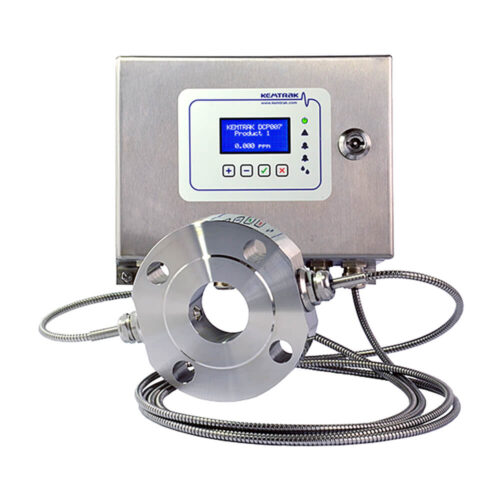 The Kemtrak DCP007-NIR is an advanced dual wavelength NIR photometer designed to accurately measure the concentration of process liquids and gasses with near-infrared (NIR) absorbance between 800 and 1550 nm. Examples of NIR measurements include moisture (water & trace water), ethanol, methanol, sodium hydroxide, ammonia and continuous fuel identification. The Kemtrak DCP007-NIR uses a long life high performance NIR LED light source with robust industrial grade fiber optics to deliver a drift and noise-free measurement with very high precision. Automatic compensation for sample turbidity and/or fouling of the optical windows ensures trouble free operation.
The Kemtrak DCP007-NIR is an advanced dual wavelength NIR photometer designed to accurately measure the concentration of process liquids and gasses with near-infrared (NIR) absorbance between 800 and 1550 nm. Examples of NIR measurements include moisture (water & trace water), ethanol, methanol, sodium hydroxide, ammonia and continuous fuel identification. The Kemtrak DCP007-NIR uses a long life high performance NIR LED light source with robust industrial grade fiber optics to deliver a drift and noise-free measurement with very high precision. Automatic compensation for sample turbidity and/or fouling of the optical windows ensures trouble free operation. -
 The Kemtrak DCP007 UV process analyzer uses ultra-low power cold light at the exact wavelength required for the analysis, exposing the sample to thousands of times less energy than a traditional UV photometer. This is achieved from a state of the art digital photometer design using a modulated high performance UV LED light source with precision fiber optics. Industrial fiber optic measurement cells for chemical concentration, platinum cobalt, hazen, saybolt, ASTM, chlorine dioxide and ICUMSA color.
The Kemtrak DCP007 UV process analyzer uses ultra-low power cold light at the exact wavelength required for the analysis, exposing the sample to thousands of times less energy than a traditional UV photometer. This is achieved from a state of the art digital photometer design using a modulated high performance UV LED light source with precision fiber optics. Industrial fiber optic measurement cells for chemical concentration, platinum cobalt, hazen, saybolt, ASTM, chlorine dioxide and ICUMSA color. -
 The Kemtrak DCP007 is an easy to operate industrial fiber optic photometer designed to accurately measure the concentration and color of process samples. Measurements are real time and in-line. The Kemtrak DCP007 uses a long life high performance LED light source with robust industrial grade fiber optics to provide drift and noise-free measurement with very high precision. A proprietary dual wavelength four channel measurement technique and advanced digital electronics design allows deep absorbance measurement to 5 AU. A range of shorter optical pathlengths allow for deeper absorbance measurements. Automatic compensation for sample turbidity and/or fouling of the optical windows ensures trouble free operation. Maintenance free measurement cells with sapphire windows have no electronics or moving parts making the unit suitable for hazardous area use.
The Kemtrak DCP007 is an easy to operate industrial fiber optic photometer designed to accurately measure the concentration and color of process samples. Measurements are real time and in-line. The Kemtrak DCP007 uses a long life high performance LED light source with robust industrial grade fiber optics to provide drift and noise-free measurement with very high precision. A proprietary dual wavelength four channel measurement technique and advanced digital electronics design allows deep absorbance measurement to 5 AU. A range of shorter optical pathlengths allow for deeper absorbance measurements. Automatic compensation for sample turbidity and/or fouling of the optical windows ensures trouble free operation. Maintenance free measurement cells with sapphire windows have no electronics or moving parts making the unit suitable for hazardous area use. -
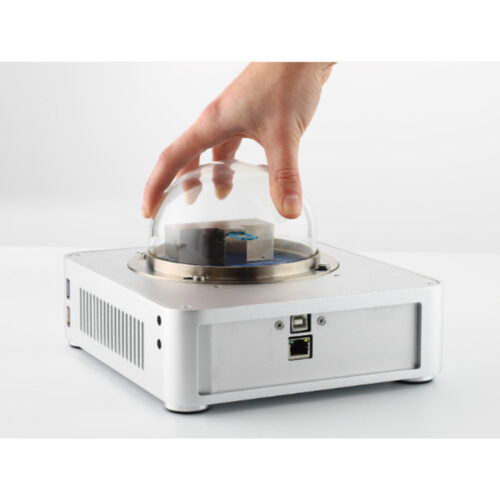
 The all new Chip DSC-sensor integrates all essential parts of DSC, furnace, sensor and electronics in a miniaturized housing. The chip-arrangement comprises the heater and temperature sensor in a chemically inert ceramic arrangement with metallic heater and temperature sensor. This arrangement allows superior reproducibility and due to the low mass outstanding temperature control and heating rates of up to 300°C/min. The integrated sensor is easily user exchangeable and available for a low cost. The integrated design of the chip-sensor delivers superior raw data, which enables a direct analysis without pre- or post-processing of heat flow data.
The all new Chip DSC-sensor integrates all essential parts of DSC, furnace, sensor and electronics in a miniaturized housing. The chip-arrangement comprises the heater and temperature sensor in a chemically inert ceramic arrangement with metallic heater and temperature sensor. This arrangement allows superior reproducibility and due to the low mass outstanding temperature control and heating rates of up to 300°C/min. The integrated sensor is easily user exchangeable and available for a low cost. The integrated design of the chip-sensor delivers superior raw data, which enables a direct analysis without pre- or post-processing of heat flow data. -
 The Differential Thermal Analysis DTA is the most common thermal analysis method due to its wide range of information provided. The Linseis high temperature DTA PT 1600 is designed to deliver highest calorimetric sensitivity, short time constants and a condensation free sample chamber. These features guarantee superior resolution and baseline stability over the entire instrument lifetime. Thus providing a indispensable tool for material development, R&D and quality control. All Linseis Differential Thermal Analyzers (DTA) comprise the advantages of latest technology, highest resolution and a robust easy to use instrument design.
The Differential Thermal Analysis DTA is the most common thermal analysis method due to its wide range of information provided. The Linseis high temperature DTA PT 1600 is designed to deliver highest calorimetric sensitivity, short time constants and a condensation free sample chamber. These features guarantee superior resolution and baseline stability over the entire instrument lifetime. Thus providing a indispensable tool for material development, R&D and quality control. All Linseis Differential Thermal Analyzers (DTA) comprise the advantages of latest technology, highest resolution and a robust easy to use instrument design. -

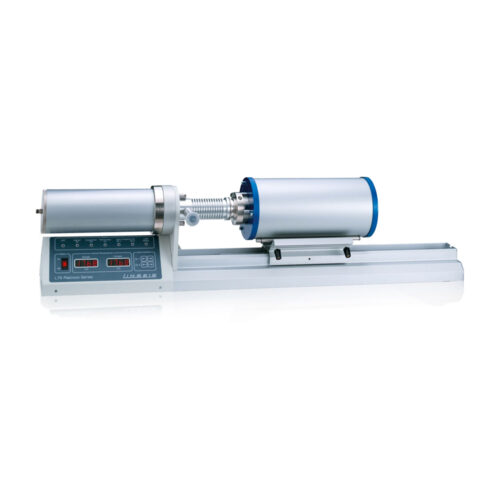 Dilatometry DIL is a technique in which a dimension of a substance under negligible load is measured (e.g. expansion measurement or shrinkage measurement) as a function of temperature while the substance is subjected to a controlled temperature program in a specified atmosphere. Linseis produces a wide range of Single-, Dual-, Differential-, Quattro-, Quenching-, Laser- and Optical Dilatometer in a temperature range from -180°C up to 2800°C and a resolution up to 0.3 nm. Thanks to our years of experience (est. 1953), Linseis offers Dilatometers with an unbeaten performance.
Dilatometry DIL is a technique in which a dimension of a substance under negligible load is measured (e.g. expansion measurement or shrinkage measurement) as a function of temperature while the substance is subjected to a controlled temperature program in a specified atmosphere. Linseis produces a wide range of Single-, Dual-, Differential-, Quattro-, Quenching-, Laser- and Optical Dilatometer in a temperature range from -180°C up to 2800°C and a resolution up to 0.3 nm. Thanks to our years of experience (est. 1953), Linseis offers Dilatometers with an unbeaten performance. -
 The Smartchem 600 combines the latest technology in discrete analysis with an innovative and unique design that guarantees accurate and reproducible results. The Smartchem range is the first discrete analyzers to utilize washable cuvettes with an integrated wash and control station, which guarantee a lower running cost and reduced risk of contamination. In addition to automated analysis the Smartchem 600 offers automated system Quality Control. The Smartchem range is also the first discrete analyzers to utilize a patented, dedicated sample prep module for the determination of NOx by Cadmium reduction. Designed for multi-tasking and high throughput rates, the NOx module also provides automated cadmium regeneration. The instrument provides also a pH, Conductivity and Redox module. Fully automated, the Smartchem 600 is available with new user-friendly software designed for touch screen computer with the possibility of wireless control. Ease of use combined with minimal operating condition requirements make the Smartchem 600 the right choice for every cost-efficiency laboratory.
The Smartchem 600 combines the latest technology in discrete analysis with an innovative and unique design that guarantees accurate and reproducible results. The Smartchem range is the first discrete analyzers to utilize washable cuvettes with an integrated wash and control station, which guarantee a lower running cost and reduced risk of contamination. In addition to automated analysis the Smartchem 600 offers automated system Quality Control. The Smartchem range is also the first discrete analyzers to utilize a patented, dedicated sample prep module for the determination of NOx by Cadmium reduction. Designed for multi-tasking and high throughput rates, the NOx module also provides automated cadmium regeneration. The instrument provides also a pH, Conductivity and Redox module. Fully automated, the Smartchem 600 is available with new user-friendly software designed for touch screen computer with the possibility of wireless control. Ease of use combined with minimal operating condition requirements make the Smartchem 600 the right choice for every cost-efficiency laboratory. -
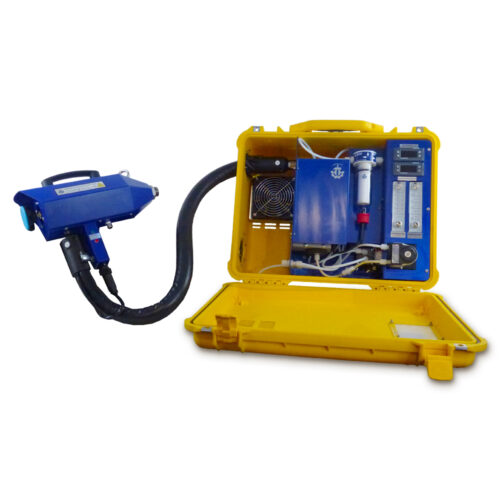
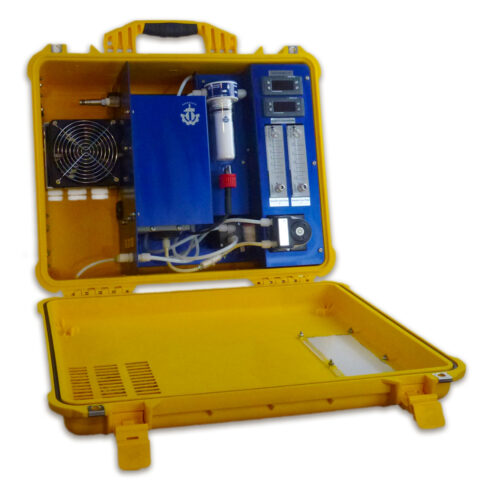
The portable system is suitable for variable, discontinuous and continuous operation. The components built into the system can be used for standard applications. For special requirements please ask us for other solutions.
The heated sample line is to be mounted at the gas measuring inlet terminal inside the portable case. A ball-valve can be fitted to the inlet terminal of the portable system in order to calibrate analyser(s) with check gas.
The amount of flow is determined by a sample gas diaphragm pump. The sample gas pump AMP 11P is activated automatically by means of an excess temperature contact on the cooler.
Optional flow meters with integrated needle valve are available. The flow meters are built-in as the electronic controller and are visible from outside when the carrying case is closed. This unique microprocessor controlled Peltier cooler is a powerful designed dew point stabiliser. The dew point is set at 4°C but can be changed at any value between 1°C and 15°C. The gas cooler is equipped with an innovative heat exchanger system.
-
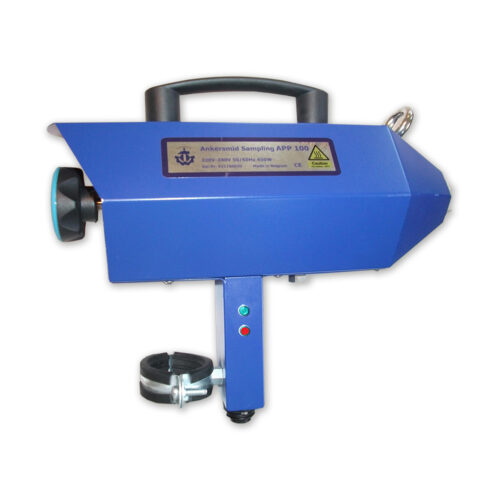
Due to various acid dew points at various applications the probe is heated up to 180°C.
A filter element of 150mm is integrated, suitable for most applications up to 1g dust/m3. A significant advantage is that this filter is replaceable without dismounting the probe. With the filter element of 150mm length this probe is suitable for most applications up to 1g dust/m3; with the blow-back function dust loads of up to 10g/m3 can be handled.
Calibration gas can be injected directly into the probe through the calibration gas connection according to EN14181 (regulation for calibration of emission monitoring systems) that enables calibration gas feeding via the filter element of the gas sample probe. The use of the optional high-flow check valve type APP 200 is recommended.
The portable gas sample probe series APP is a perfect completion to the Ankersmid portable gas conditioning system series APS 303/313. Both devices can easily be connected together by the Ankersmid heated sample line type AHL205/025 with the incorporated innovative Quick-Lock System which guarantees a fast and reliable connection.
Using this heated line the probe's electrical power is then fed to the probe via the feed line integrated within the sample line. To avoid cooling-down and condensation of sample gas in the extraction area, the heated sample probe tube type AST 301 is available.
-
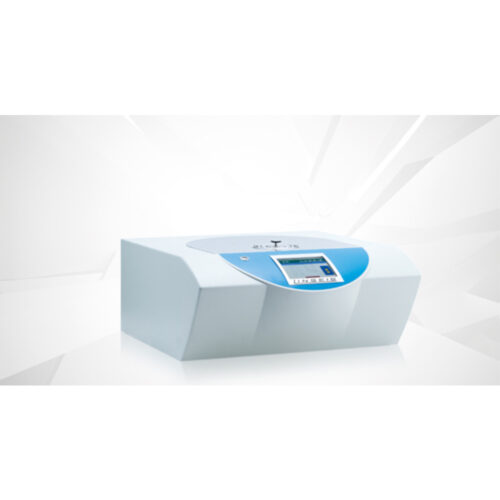 The DSC PT 1000 was developed to provide a general purpose TM – DSC with a broad temperature range (-180 – 600°C) for all common applications. Furthermore emphasis was placed on an extremely stable baseline and high reproducibility. The design allows manual and automatic operation. The conception of the cell guarantees maximum mechanical and chemical resistance. The key part of every DSC is the sensor, so don’t make any compromise. Up to now it has been impossible to achieve highest resolution and sensitivity in one sensor. The revolutionary design of the HiperRes® Sensor line now enables just that. The Ceramic/Metal Sensor deliver outstanding resolution in combination with superior reproducibility.
The DSC PT 1000 was developed to provide a general purpose TM – DSC with a broad temperature range (-180 – 600°C) for all common applications. Furthermore emphasis was placed on an extremely stable baseline and high reproducibility. The design allows manual and automatic operation. The conception of the cell guarantees maximum mechanical and chemical resistance. The key part of every DSC is the sensor, so don’t make any compromise. Up to now it has been impossible to achieve highest resolution and sensitivity in one sensor. The revolutionary design of the HiperRes® Sensor line now enables just that. The Ceramic/Metal Sensor deliver outstanding resolution in combination with superior reproducibility. -
 Differential Scanning Calorimetry (DSC) is the most common thermal analysis method due to its wide range of information provided. The LINSEIS high temperature DSC PT 1600 (HDSC/DTA) is designed to deliver highest calorimetric sensitivity, short time constants and a condensation free sample chamber. These features guarantee superior resolution and baseline stability over the entire instrument lifetime. This provides an indispensable tool for material development, R&D and quality control. The modular concept of the HDSC and DTA systems allows the use of different furnaces with a temperature range from -150°C up to 1750°C. The vacuum tight design enables quantitative enthalpy and Cp (Specific Heat) determination under the cleanest atmospheres and under vacuum of 10E-5mbar. The systems can be upgraded with an optional sample robot and coupled to a MS or FTIR. Measuring System: User friendly exchangeable measureing systems such as a DTA Sensor and two different DSC Sensors are available. Each DSC Sensor is available as type E, K, S, B for the DSC PT 1600. This allows the perfect chioce for any application, temperature or atmosphere.
Differential Scanning Calorimetry (DSC) is the most common thermal analysis method due to its wide range of information provided. The LINSEIS high temperature DSC PT 1600 (HDSC/DTA) is designed to deliver highest calorimetric sensitivity, short time constants and a condensation free sample chamber. These features guarantee superior resolution and baseline stability over the entire instrument lifetime. This provides an indispensable tool for material development, R&D and quality control. The modular concept of the HDSC and DTA systems allows the use of different furnaces with a temperature range from -150°C up to 1750°C. The vacuum tight design enables quantitative enthalpy and Cp (Specific Heat) determination under the cleanest atmospheres and under vacuum of 10E-5mbar. The systems can be upgraded with an optional sample robot and coupled to a MS or FTIR. Measuring System: User friendly exchangeable measureing systems such as a DTA Sensor and two different DSC Sensors are available. Each DSC Sensor is available as type E, K, S, B for the DSC PT 1600. This allows the perfect chioce for any application, temperature or atmosphere. -
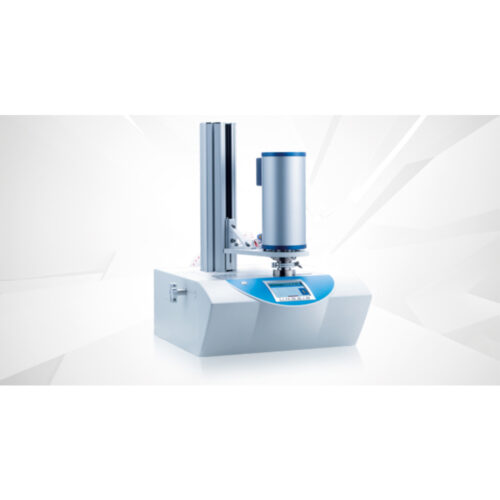 The Differential Thermal Analysis is the most common thermal analysis method due to its wide range of information provided. The Linseis high temperature DTA PT 1600 is designed to deliver highest calorimetric sensitivity, short time constants and a condensation free sample chamber. These features guarantee superior resolution and baseline stability over the entire instrument lifetime. Thus providing a indispensable tool for material development, R&D and quality control. All Linseis Differential Thermal Analyzers (DTA) comprise the advantages of latest technology, highest resolution and a robust easy to use instrument design.
The Differential Thermal Analysis is the most common thermal analysis method due to its wide range of information provided. The Linseis high temperature DTA PT 1600 is designed to deliver highest calorimetric sensitivity, short time constants and a condensation free sample chamber. These features guarantee superior resolution and baseline stability over the entire instrument lifetime. Thus providing a indispensable tool for material development, R&D and quality control. All Linseis Differential Thermal Analyzers (DTA) comprise the advantages of latest technology, highest resolution and a robust easy to use instrument design. -
 The Dustroid Pro is an Online Dust Monitoring System specially developed for dust levels for critical applications. Dustroid Pro operates on the Laser Scattering Working Principle. Dustroid comes with a heated inlet for dehumidification of air-sample for improved accuracy and stability. The heated inlet reduces dehumidifies the air sample by reducing humidity up to 60%, which makes it an ideal solution for dust monitoring in Humid places. Hence, Dustroid pro is the most reliable dust monitor, its design helps in effective dust level monitoring at critical applications such as Construction dust monitoring, Mining dust monitoring, Quarrying dust monitoring, Thermal Power Plant Dust Monitoring, Cement Factory dust monitoring. Monitoring around heavy dust-laden activities is very important as they have a direct impact on the surrounding areas and the employees working on the premises. Therefore, through efficient dust monitoring, timely steps can be taken to activate dust suppression activities. With an increase of smart dust mitigation systems, they can be automated using the accurate particulate matter data derived from the Dustroid Pro. Dustroid Pro measures all the PM parameters like PM1, PM2.5, PM10, PM100, Temperature and Humidity. The Dustroid Pro is technologically equipped to offer higher accuracy with a heated inlet for humidity correction for Particulate monitoring, Auto device firmware updates, an Anti-static inlet to avoid loss of particulate during sampling and remote calibration capabilities. Our intelligent optical particle counter can transmit data through various data communication modules such as GSM, WiFi, LORA, etc. The data is transmitted to the Oizom cloud in near real-time. Additionally, it has an inbuilt memory backup to ensure no data loss in case of network failure. So, the collected data can be visualized on the Oizom IoT Terminal in the form of real-time dashboards, automated reports, and smart alerts. The data is also accessible through Rest APIs for setting triggers and alerts to automate dust mitigation systems like fogging cannons, misting systems and ambient dust purification systems.
The Dustroid Pro is an Online Dust Monitoring System specially developed for dust levels for critical applications. Dustroid Pro operates on the Laser Scattering Working Principle. Dustroid comes with a heated inlet for dehumidification of air-sample for improved accuracy and stability. The heated inlet reduces dehumidifies the air sample by reducing humidity up to 60%, which makes it an ideal solution for dust monitoring in Humid places. Hence, Dustroid pro is the most reliable dust monitor, its design helps in effective dust level monitoring at critical applications such as Construction dust monitoring, Mining dust monitoring, Quarrying dust monitoring, Thermal Power Plant Dust Monitoring, Cement Factory dust monitoring. Monitoring around heavy dust-laden activities is very important as they have a direct impact on the surrounding areas and the employees working on the premises. Therefore, through efficient dust monitoring, timely steps can be taken to activate dust suppression activities. With an increase of smart dust mitigation systems, they can be automated using the accurate particulate matter data derived from the Dustroid Pro. Dustroid Pro measures all the PM parameters like PM1, PM2.5, PM10, PM100, Temperature and Humidity. The Dustroid Pro is technologically equipped to offer higher accuracy with a heated inlet for humidity correction for Particulate monitoring, Auto device firmware updates, an Anti-static inlet to avoid loss of particulate during sampling and remote calibration capabilities. Our intelligent optical particle counter can transmit data through various data communication modules such as GSM, WiFi, LORA, etc. The data is transmitted to the Oizom cloud in near real-time. Additionally, it has an inbuilt memory backup to ensure no data loss in case of network failure. So, the collected data can be visualized on the Oizom IoT Terminal in the form of real-time dashboards, automated reports, and smart alerts. The data is also accessible through Rest APIs for setting triggers and alerts to automate dust mitigation systems like fogging cannons, misting systems and ambient dust purification systems. -
 The Dustroid Smart is an air particulate monitoring device specially developed to monitor ambient dust particles. The Dustroid Smart is a compact and connected optical particle counter which offers near real-time particulate matter count. The easy to install and the requirement for minimal space for deployment make it a scalable solution to create a dense network of data points. The Smart version is specially designed for creating a quality sensor network for crucial applications like Smart Cities, Roadside monitoring, Tunnel monitoring. Globally 25% of urban ambient air pollution is from particulate matter. Particulate matter is one of the most harmful pollutants. It causes several health hazards such as non-fatal heart attacks, irregular heartbeat, aggravated asthma, decreased lung function. Monitoring in tunnels enable ventilation fans automation, roadside monitoring enables the city authorities to identify the impact of vehicular emissions on the total PM generation of the city. Other activities like coal and charcoal burning also play a major role in increased levels of particulate matter. In order to mitigate the dust levels, it is necessary to identify the exact sources of dust pollution and apply necessary mitigation strategies. Dustroid Smart – dust monitoring device measures all the PM parameters like PM1, PM2.5, PM10, PM100, Temperature, and Humidity. The Dustroid Smart is technologically equipped to offer higher accuracy with features, humidity correction for Particulate monitoring, Auto device firmware updates, Anti-static inlet to avoid loss of particulate during sampling, and remote calibration capabilities Our intelligent optical particle counter can transmit data through various data communication modules such as GSM, WiFi, LORA, etc. The data is transmitted to the Oizom cloud in near real-time. Additionally, it has an inbuilt memory backup to ensure no data loss in case of network failure. The collected data can be visualized on the Oizom IoT Terminal in the form of real-time dashboards, automated reports, and smart alerts. The data can also be accessible through Rest APIs for integration into 3rd party software and automated dust suppression.
The Dustroid Smart is an air particulate monitoring device specially developed to monitor ambient dust particles. The Dustroid Smart is a compact and connected optical particle counter which offers near real-time particulate matter count. The easy to install and the requirement for minimal space for deployment make it a scalable solution to create a dense network of data points. The Smart version is specially designed for creating a quality sensor network for crucial applications like Smart Cities, Roadside monitoring, Tunnel monitoring. Globally 25% of urban ambient air pollution is from particulate matter. Particulate matter is one of the most harmful pollutants. It causes several health hazards such as non-fatal heart attacks, irregular heartbeat, aggravated asthma, decreased lung function. Monitoring in tunnels enable ventilation fans automation, roadside monitoring enables the city authorities to identify the impact of vehicular emissions on the total PM generation of the city. Other activities like coal and charcoal burning also play a major role in increased levels of particulate matter. In order to mitigate the dust levels, it is necessary to identify the exact sources of dust pollution and apply necessary mitigation strategies. Dustroid Smart – dust monitoring device measures all the PM parameters like PM1, PM2.5, PM10, PM100, Temperature, and Humidity. The Dustroid Smart is technologically equipped to offer higher accuracy with features, humidity correction for Particulate monitoring, Auto device firmware updates, Anti-static inlet to avoid loss of particulate during sampling, and remote calibration capabilities Our intelligent optical particle counter can transmit data through various data communication modules such as GSM, WiFi, LORA, etc. The data is transmitted to the Oizom cloud in near real-time. Additionally, it has an inbuilt memory backup to ensure no data loss in case of network failure. The collected data can be visualized on the Oizom IoT Terminal in the form of real-time dashboards, automated reports, and smart alerts. The data can also be accessible through Rest APIs for integration into 3rd party software and automated dust suppression. -
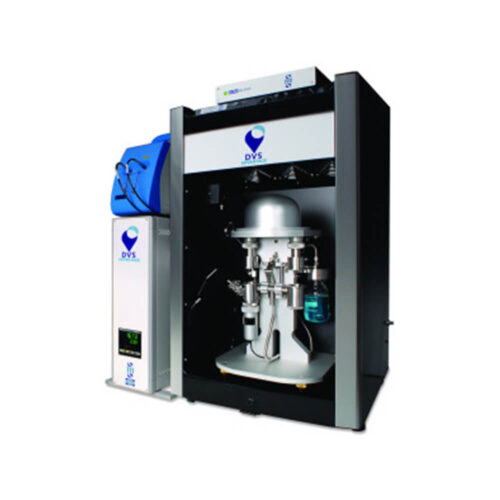 Dynamic Vapor Sorption (DVS) is a gravimetric technique that measures how quickly and how much of a solvent is absorbed by a sample. It does this by varying the vapor concentration surrounding the sample and measuring the change in mass loss or uptake. Water vapor is most commonly used, but it is also possible to use a wide range of organic solvents. The DVS instrument rapidly measures uptake and loss of moisture or organic vapours by flowing a carrier gas at a specified relative humidity over a sample (which can weigh between 1 mg and 4 g) suspended from the weighing mechanism of an ultra-sensitive recording microbalance. This particular microbalance is used as it is capable of measuring changes in sample mass lower than 0.1ppm , providing unrivalled long-term stability required for accurate measurements of vapour sorption, which may take from minutes to days to complete depending upon the sample size and material. A big factor of sorption behaviour is the need to establish rapid sorption. So the DVS instrument allows sorption behaviour to be accurately determined on very small sample sizes (typically 10 mg) to have a fast expiriment.
Dynamic Vapor Sorption (DVS) is a gravimetric technique that measures how quickly and how much of a solvent is absorbed by a sample. It does this by varying the vapor concentration surrounding the sample and measuring the change in mass loss or uptake. Water vapor is most commonly used, but it is also possible to use a wide range of organic solvents. The DVS instrument rapidly measures uptake and loss of moisture or organic vapours by flowing a carrier gas at a specified relative humidity over a sample (which can weigh between 1 mg and 4 g) suspended from the weighing mechanism of an ultra-sensitive recording microbalance. This particular microbalance is used as it is capable of measuring changes in sample mass lower than 0.1ppm , providing unrivalled long-term stability required for accurate measurements of vapour sorption, which may take from minutes to days to complete depending upon the sample size and material. A big factor of sorption behaviour is the need to establish rapid sorption. So the DVS instrument allows sorption behaviour to be accurately determined on very small sample sizes (typically 10 mg) to have a fast expiriment. -
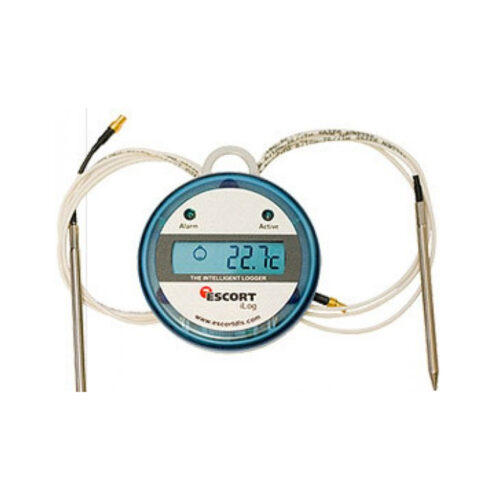
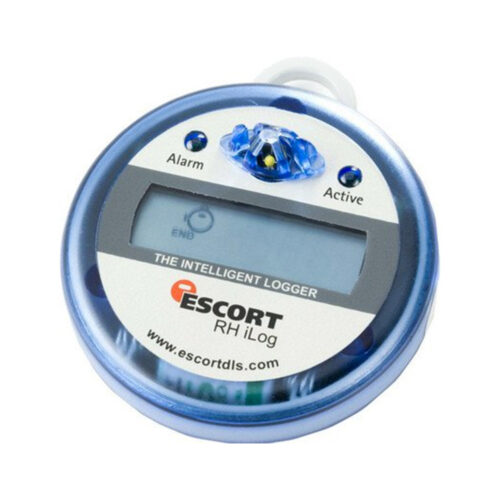 We have a whide variaty of sensors, loggers/recorders for temperature and humidty. Digital temperature data logger with display Escort MINI is a self-sufficient data logger that measures temperature. To start logging, a brief pressure on start button is enough. A large LCD display provides log information and alarm status. Escort MINI’s enclosure is made of ABS plastic and has an optional internal or external probe. The internal memory logs up to 1868 readings, with a sample rate from 1 up to 255 minutes. iLog is a self-powered temperature data logger. An excelent resolution of 0,1ºC along with a high accuracy of ±0,3ºC gives the iLog the capability to detect and to log the smallest variations of temperature. A large LCD display and external indicators provide log information and alarm status. The internal memory logs up to 32000 readings, with a sample rate from 1 second up to 10 days.
We have a whide variaty of sensors, loggers/recorders for temperature and humidty. Digital temperature data logger with display Escort MINI is a self-sufficient data logger that measures temperature. To start logging, a brief pressure on start button is enough. A large LCD display provides log information and alarm status. Escort MINI’s enclosure is made of ABS plastic and has an optional internal or external probe. The internal memory logs up to 1868 readings, with a sample rate from 1 up to 255 minutes. iLog is a self-powered temperature data logger. An excelent resolution of 0,1ºC along with a high accuracy of ±0,3ºC gives the iLog the capability to detect and to log the smallest variations of temperature. A large LCD display and external indicators provide log information and alarm status. The internal memory logs up to 32000 readings, with a sample rate from 1 second up to 10 days. -
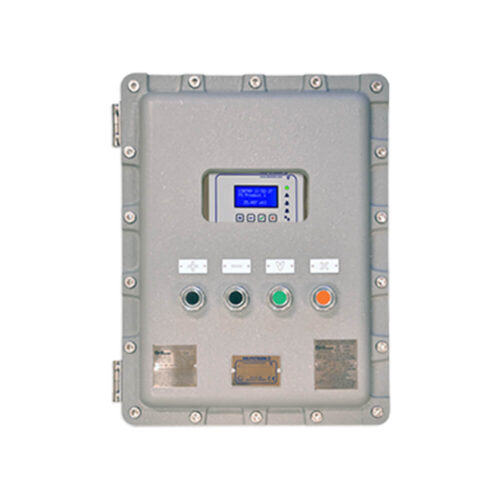 The Kemtrak EX-D3 hazardous area enclosure allows the use of a Kemtrak 007 series process analyzer in potentially explosive atmospheres. The primary function of an Ex d enclosure is to prevent the propagation of an internal explosion to the surrounding explosive atmosphere and protecting the internal components from the environment, humidity, dirt, dust or water. A window on the front of the enclosure is used to view the analyzer display and status lamps while four external push-buttons provide complete operation control of the instrument. All Kemtrak products use fiber optics and maintenance free measurement cells with no electronics or moving parts to perform the measurement. Fiber optics are ideally suited for use in explosive environments as they only allow transmission of ultra-low power cold light.
The Kemtrak EX-D3 hazardous area enclosure allows the use of a Kemtrak 007 series process analyzer in potentially explosive atmospheres. The primary function of an Ex d enclosure is to prevent the propagation of an internal explosion to the surrounding explosive atmosphere and protecting the internal components from the environment, humidity, dirt, dust or water. A window on the front of the enclosure is used to view the analyzer display and status lamps while four external push-buttons provide complete operation control of the instrument. All Kemtrak products use fiber optics and maintenance free measurement cells with no electronics or moving parts to perform the measurement. Fiber optics are ideally suited for use in explosive environments as they only allow transmission of ultra-low power cold light.


